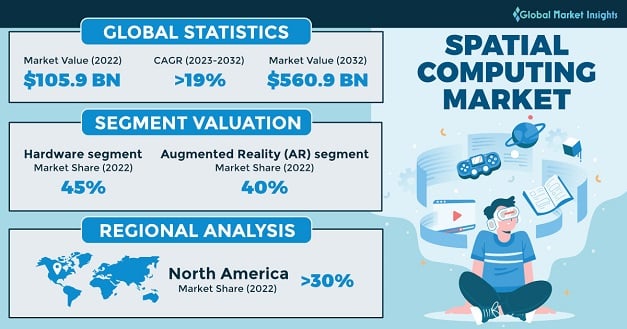Home > Media & Technology > Information Technology > Cloud Computing > Spatial Computing Market
Spatial Computing Market Size
- Report ID: GMI6775
- Published Date: Sep 2023
- Report Format: PDF
Spatial Computing Market Size
Spatial Computing Market size was valued at USD 105.9 billion in 2022 and is estimated to register a CAGR of over 19% between 2023 and 2032. Technological advancements are a primary factor spurring the market growth. Constant improvements in hardware and software components, such as more powerful processors, higher-resolution displays, and precise sensors, enhance the user experience. These advancements lead to more immersive & interactive augmented and virtual reality experiences, making spatial computing increasingly appealing to consumers and businesses alike. As technology continues to evolve, it enables the development of innovative applications across various industries.
The surging popularity of Augmented Reality (AR) and Virtual Reality (VR) is a significant catalyst for the spatial computing market's expansion. With consumers increasingly embracing AR and VR for immersive gaming, entertainment, and interactive experiences, the demand for spatial computing technologies has escalated. This heightened interest is fueling investments, innovations, and content creation within the industry. Consequently, the market is witnessing a substantial growth as it leverages this growing consumer preference for AR & VR applications and devices.
| Report Attribute | Details |
|---|---|
| Base Year: | 2022 |
| Spatial Computing Market Size in 2022: | USD 105.9 Billion |
| Forecast Period: | 2023 to 2032 |
| Forecast Period 2023 to 2032 CAGR: | 19% |
| 2032 Value Projection: | USD 560.9 Billion |
| Historical Data for: | 2018 to 2022 |
| No. of Pages: | 300 |
| Tables, Charts & Figures: | 279 |
| Segments covered: | Component, Technology, End-user |
| Growth Drivers: |
|
| Pitfalls & Challenges: |
|
High costs associated with superior-quality AR and VR hardware pose a significant hurdle for the spatial computing market. Premium devices often come with steep price tags, restricting access for both consumers and businesses. Mitigating this challenge involves finding ways to manufacture affordable yet high-quality hardware solutions, making them more accessible to a broader audience. Striking the right balance between cost-effectiveness and performance will be crucial to encourage wider adoption and boost the industry growth.

